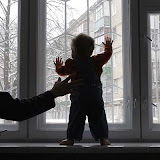Compared to
his boisterous neighbors, Suzuki moves as quietly as a whisper. So shy we can
barely hear him speak, he looks like he wishes he could vanish, or shrivel up
like the brown leaf in his hand. After a few false starts, I ask about his
plants and he proudly begins to explain. He tells us how he cares for the
delicate tiny trees and shrubs, and discusses uses of the flowers and herbs.
Bit by bit
his story comes out. Like his neighbors, Suzuki was a farmer in Kawauchi. He is
wiry and must be over 70 but moves like a younger man. He owned seven cows, he
says, but he had to kill them all after the radiation came. For a time he lived
here with his family of five, but they left to move further north, to Fukushima
city. They tell him their new housing is much better up there, but he refuses
to move a second time. Why? Because of the plants. Already he’s had to give up
all his gardens once. He can’t bear to do it again. Since he could not take
these new plants with him, he chooses to live here, alone, rather than uproot.
“I have no
vision for the future,” he says. “Summer here is too hot and winter too cold.”
Across the
sea of asphalt stands another block of apartments. A man comes barefoot out of
building H-15 and sits cross-legged on his front deck. He begins shaving there,
and calls out to us as we pass by.
Yukio Kubota
is also from Kawauchi town. On March 15, 2011, four days after the earthquake,
he and his wife evacuated to Niigata, his wife’s hometown on the west coast.
She has stayed with relatives for the past year but he returned to Fukushima Prefecture
to be closer to home.
Once last
summer he returned home for a few days. The weeds were more than a meter high,
he says. “The first day we cut weeds. The second day we removed all soil in the
garden up to 5 cm deep. The radiation inside the house was 4.3 μSv per hour,
but we didn’t have a Geiger counter so we were sleeping in this place.” They
left when they learned how high the radiation still was.
A note on
radiation dose: 1 Sievert is 1000 milliSieverts (mSv) is one million
microSieverts (μSv). To compare, the peak level measured in this part of the
Exclusion Zone (330 μSv/hr on 3/15/11) (1) was 76 times higher than the dose inside
Yukio’s house; however his house level was still 12 times more than typical
background radiation. The EPA recommends an annual dose limit of 1 mSv per
year, which Yukio would reach inside his house in less than 10 days.
Here is a
useful chart that illustrates doses.
Symptoms of
Acute Radiation Sickness generally start above 350 mSv — 81,400 times the
hourly dose at Yukio’s. This leads some Japanese to conclude there is nothing
to worry about. However, just because you’re not keeling over today doesn’t
mean there is no risk of future disease (as I discussed here).
Now, a year
later, government workers have finally decontaminated his house and yard. The initial
new reading was 1 to 2 μSv per hour. “I am waiting to see the radiation levels
before I decide to move home,” he says.





